China's Mid-Autumn Festival is traditionally celebrated on the fifteenth day of the eighth lunisolar month (somewhere in the period early September to early August). The festival is the second most imp
Chang'e and Hou Yi
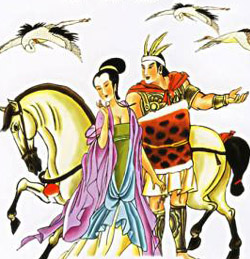 Long long ago, there were 10 suns in the sky. They burnt all the plants on the earth. People were dying.
Long long ago, there were 10 suns in the sky. They burnt all the plants on the earth. People were dying.
On
On
Hou Yi was becoming more and more famous after he shot down the nine suns and more and more men wanted Hou Yi to be their master. Most of them were accepted by Hou Yi.
Not every student of Hou Yi had good morality. Feng Meng, on
From then on, people often pray to Chang'e for fortune and safety. During the Mid-Autumn Festival they offer lots of foods to Chang'e.
Wu Gang and the Cherry Bay
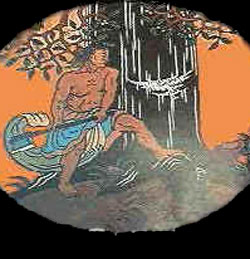 Wu Gang was a woodchopper. He always wanted to become an immortal, but he never tried his best to learn the necessary theurgy. The Jade Emperor got angry with him because of his attitude. In order to punish him, the Jade Emperor planted a huge cherry bay, which was 1665 meters (5460 ft) high, on the moon and ordered Wu Gang to chop it down, then Wu Gang could become an immortal.
Wu Gang was a woodchopper. He always wanted to become an immortal, but he never tried his best to learn the necessary theurgy. The Jade Emperor got angry with him because of his attitude. In order to punish him, the Jade Emperor planted a huge cherry bay, which was 1665 meters (5460 ft) high, on the moon and ordered Wu Gang to chop it down, then Wu Gang could become an immortal.
This time, Wu Gang was very serious, but he could never finish his work. The cherry bay healed every time that Wu Gang chopped it. Wu Gang wouldn’t give up. He tried time and time again.
On unclouded nights people can see some obvious shadows on the moon. They are made by the huge cherry bay.
The Jade Rabbit
On
Customes of Middle-Autumn Festival
General Customs
Gazing at the Moon
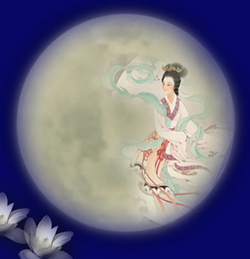 Appreciating the moon has been a custom since the Tang Dynasty (618–907). Not on
Appreciating the moon has been a custom since the Tang Dynasty (618–907). Not on
Nowadays, people still like appreciating the moon on Mid-Autumn Festival in China. Chinese family members have dinner together in the evening of Mid-Autumn Festival. After the dinner, they may talk about their work, the children, and their future plans. Sometimes, people go to a park to see the decorations made for the festival.
Eating Moon Cakes
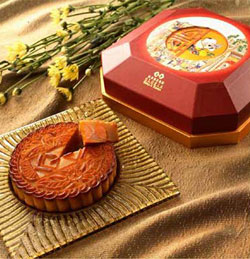 At the end of Yuan Dynasty (1271–1368, a dynasty ruled by the Mongols), the Han people’s army wanted to overthrow the rule of the Mongols, so they planed an uprising, but they had no way to inform every Han who wanted to join them of the time of the uprising without being discovered by the Mongols. On
At the end of Yuan Dynasty (1271–1368, a dynasty ruled by the Mongols), the Han people’s army wanted to overthrow the rule of the Mongols, so they planed an uprising, but they had no way to inform every Han who wanted to join them of the time of the uprising without being discovered by the Mongols. On
Nowadays, people also like appreciating the moon on Autumn Moon Festival. Family members have dinner together on the evening of the festival.
Making Chinese Mid-Autumn Lanterns
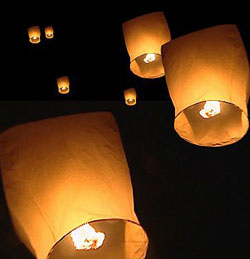 Mid-Autumn lanterns are not as colorful as those of the Lantern Festival. There is no big lantern party during Mid-Autumn Festival, but children like making colorful lanterns very much. They make lanterns of different shapes and let them float on the rivers. They don’t leave the riverside until the light of the lanterns disappears. Sometimes, they make Kongming (Hung Ming) lanterns, which can fly because the burning candles heat the air in the lantern. The lantern rises with the heated air.
Mid-Autumn lanterns are not as colorful as those of the Lantern Festival. There is no big lantern party during Mid-Autumn Festival, but children like making colorful lanterns very much. They make lanterns of different shapes and let them float on the rivers. They don’t leave the riverside until the light of the lanterns disappears. Sometimes, they make Kongming (Hung Ming) lanterns, which can fly because the burning candles heat the air in the lantern. The lantern rises with the heated air.
Regional Customs
Customs of Middle-Autumn Festival in Old Beijing
Most of these customs have been forsaken with the modernization of the city. Today, they are still remembered by those who strive to keep their centuries-old tradition.
Worshiping the Moon
In old days, a platform for moon worshipping was set up in each house when the Mid-Autumn Festival approached. The offerings on the platform were mainly mooncakes and sometimes fruits were added. Fruits were meticulously arranged according to tradition. Peaches and pomegranates were traditionally put together, which symbolized big families; chestnuts and persimmons were arranged together, symbolizing prosperity; and longans were sprinkled, meaning family unity. For families with members far away from home, a bowl of lotus roots was laid, which expressed that the people away were missed.
Watching the Moon
Watching the moon was very popular in Beijing. There are two methods of moon-gazing: watching the moon directly and watching the reflection of the moon in water. Other entertainments accompanying watching the moon included writing prose, painting the moon and guessing riddles written on lanterns.
Watching Flowers
A "flower mountain" made up of pots of various flowers was set up on the window sill of each house when the Mid-Autumn Festival was near. On the night of the festival, the family would gather and watch the flowers.
Playing with Rabbit Figurines
A rabbit figurine is a popular Mid-Autumn Festival toy in old Beijing. The figurine is an artistic image of a personified or even deified rabbit based on the legendary jade rabbit on the moon. The figurines are made of clay and come in various shapes, but all are white-faced, wearing golden helmets and armors, with flags or canopies on the back. They ride such animals as lions, tigers, deer and elephants.
Rabbit figurines began to appear in markets from early in the eighth Chinese month (somewhere in the period late August to late September).They were the most popular items in the month of the Mid-Autumn Festival.
Nowadays, rabbit figurines have been gradually forgotten. The on
Customs of Mid-Autumn Festival in Guangzhou
Hanging lanterns
Hanging lanterns
Each family makes lanterns with bamboo strips as the Mid-Autumn Festival approaches. The lanterns are made into various shapes, with representations of animals, fruit and insects. Candles are lit inside the lanterns at night and smaller lanterns are stringed to the main lantern. The strings of lanterns are then tied to a bamboo pole, which is fixed in front of the door or hung in trees. This practice is believed to bring good luck to the family. The height of the lanterns is said to determine the level of luck the family will enjoy: the higher the lanterns, the luckier the family will be.
Eating river snails
River snails are traditionally an indispensable food of a Mid-Autumn Festival dinner for people in Guangzhou. River snails are usually cooked with medicinal herbs to dispel the unpleasant smell of the snails. Eating river snails during the Mid-Autumn Festival is believed to help brighten the eyes.
Worshipping the moon
In the areas of Chaozhou and Shantou in Guangdong Province, women and children worship the moon on Mid-Autumn Festival nights. As the night falls, they burn joss sticks in front of a table with offerings of fresh fruits on . Good wishes are whispered to the moon when worshipping in hope that the moon would bring them good luck.
Bathing in the moonlight
In old days, women in Dongguan believed that the moon was a matchmaker. Families with young men or women who had not found their beloved would burn incense under the moon and beg the moon to bring them their love. Tradition has it that women might become pregnant if they quietly bathed in the moonlight on the night of the Mid-Autumn Festival. In some areas, on the moonlit night of the Mid-Autumn Festival, some women, who were married for a long time but were infertile, went out of their houses and bathed in the moonlight all the while wishing to have lovely babies. People called this "moon bathing"
Custom of Mid-Autumn Festival in Hong Kong
The Fire Dragon Dance is the most traditional custom of Mid-Autumn Festival in Hong Kong. From the night of the 14th of the eighth lunar month (in the period from early September to early October), a grand three-night fire dragon dance is held in Tai Hang, Causeway Bay. The fire dragon is over 70m (230 ft) long. The dragon body is comprised of 32 sections which are stuck full of long joss sticks. On the pageant night, in streets or lanes in this block, lines of winding and undulating fire dragons will dance joyfully under the light of lanterns to music of dragon drums. It is very noisy! There is a legend about the origin of the Hong Kong fire dragon dance on Mid-Autumn Festival... On
No matter how many traditional superstitions the legend has, China is the homeland of dragons. In Hong Kong, the Tai Hang fire dragon dance during the Mid-Autumn Festival has had a history of more than 100 years, and that is worth cherishing. Nowadays, the Tai Hang fire dragon dance is large in scale, excluding the head coach, coaches, commander-in-chief, commanders and security groups, dragon dancers can be over 30,000.
Custom of Mid-Autumn Festival in Shanghai
Customs of Mid-Autumn Festival in Shanghai include worshiping the moon and burning incense. When the moon rises, people set tables in the open air and offer mooncakes, melons, fruit, green soybeans, taro, lotus roots and so on. Moon Palace magical figure paintings show the Jade Hare standing with a club are offered as well. In ancient times, it was said the moon belonged to yin (the female part of the yin-yang philosophy), so in the full moon celebration women worshipped the moon first, then the men. It was also said that "Men needn't celebrate the full moon". When the full moon celebration is done, family members drink reunion wine and have an admiration-of-the-moon dinner. A woman lodging at her parental home must return to her husband's family on the evening of the Mid-Autumn Festival to celebrate the Mid-autumn Festival. Going on a walk and admiring the full moon is called "zou yueliang" (‘moon walking’) by Shanghainese. Women taking a walk at night with friends is called "ta yue” (a moonlight stroll). Lujia Stone Bridge is outside Xiaodongmen, Shanghai, under which the reflection of the bright moon bobbling in the water contrasts adorably with the shining moon in the sky. So tourists come like hungry carp, rushing to watch. This is on
There is a custom of incense altars (called shaoxiang dou) among Shanghai people. The incense altars, also called douxiang, are made by traditional offerings shops, in a truncated square-based pyramid shape, standing large end up. Large on
Customs of Mid-Autumn Festival in Xiamen
As the Mid-Autumn Festival approaches, when the night comes, streets and lanes in Xiamen will come alive with the euphonious clang of dice colliding with china bowls during moon cake gambling. Xiamen's "moon cake gambling" is also called "the Mid-Autumn Festival cake gambling" or "festival cake gambling". The formation of this custom is related to Zheng Chenggong, a national hero. It is told that Zheng Chenggong stationed his troops in Xiamen more than 300 years ago, on the full moon night of the 15th day of the eighth Chinese month, officers and soldiers, who were full of the heroic spirit that overturned the Qing Dynasty (1644–1911) and reinstated the Ming Dynasty, found it hard to avoid feelings of missing hometowns and folks. To resolve and relieve soldiers' pains of missing hometowns and folks during the festival, Hong Xu, who served under Zheng Chenggong, devised a mooncake gambling game to let soldiers admire the full moon and gamble for mooncakes. Zheng Chenggong personally approved that, during six nights from the 13th to the 18th of the eighth lunisolar month, the army would admire the full moon and gamble for moon cakes in turns according to odd and even dates. Later, this unique custom was gradually disseminated and improved among locals, becoming an interesting folk activity. In the first year relatives and friends or sworn brothers and sisters would club together to buy a box of moon cakes or two and gamble together. Whoever won would give everybody a box of moon cakes to gamble with next Mid-Autumn Festival. If anyone had a child, the winner should give him/her two boxes. Thus, there is increase in mooncakes, but no decrease year by year, so they would have to divide into two independent groups again. The gambling is hosted by the elder of a common family, who buys a box or two of mooncakes each year. All the family members gamble in a ring.
Customs of Ethnic Minorities on Mid-autumn Day
Dai Ethnic People
Customs of sacrificing and worshipping the moon equally flourish in minorities. On the evening of the Mid-Autumn Festival, moon worship is popular among the Dai people in Yunnan. Based on the Dai legend, the moon was on
Oroqen Ethnic people
In sacrificing to the moon, Oroqen people put a basin of water in the open, set offerings there, and then kneel down before the basin and kowtow to the moon. Tu people fill the basin with clear water so that the reflection of the moon can project into the basin, and then, people ceaselessly strike the moon in the basin with little stones, which is called "striking the moon".
Zhuang Ethnic People
The activity of "sacrificing to the moon and inviting gods" of Zhuang people in West Guangxi is more typical. In the middle of the eighth month of the lunisolar calendar, on the evening of the Mid-Autumn Festival, at the village head and end people will set an altar, placing the sacred offerings and censers, and erect a branch or bamboo pole, about on
Mongolian Ethnic People
Mongolians "chase the moon". On the evening of the Mid-Autumn Festival, Mongolians enjoy playing the game of "chasing the moon". People will mount their horses, galloping on the grasslands under the silver-white moonlight. They gallop towards the west, with the moon rising in the east and setting in the west. Tenacious Mongolian riders will not stop "chasing the moon" until the moon sets in the west.
Tibetan People
Tibetans "look for the moon". The custom for Tibetan people in some areas of Tibet to celebrate the Mid-Autumn Festival is called "looking for the moon". On that night, young men, women and children search for the moon’s reflection in ponds, following the reflection of the moon in the water along the river, and then go home for reunions and moon cakes.
Hezhe People
The Hezhe people enjoy "moon worship". In the Hezhe settlements of the northeast of China, every Mid-Autumn Festival, people will pick grapes and worship the moon. It is said to be in commemoration of a clever and laborious Hezhe wife. She could not suffer her mother-in-law's sadism and escaped to the riverside to beg for the moon's help. Finally, she ran on
De'ang People
De'ang people enjoy "dating under the moon (chuanyue or chuanyueliang)", a De’ang courtship custom. Young De'ang men and women in Luxi, Yunnan, go out on
A'xi People
A'xi people, a branch of the Yi ethnic group, "dance in the moon". "Dancing in the moon" is the traditional custom of A'xi people at Mid-Autumn Festival. On the evening of the Mid-Autumn Festival, people from every village will gather on the open ground of the mountain village. Girls in veils dance, as do the guys carrying the big sanxians (three-stringed Chinese instruments) on their shoulders. However, more intriguing still is the antiphonal singing as young men and women express their loving feelings to each other.
Miao People
Miao people enjoy "teasing in the moon (naoyue)". On the evening of the Mid-Autumn Festival, the Miao people will stream along the narrow paths in the silk-like moonlight, playing the melodious lusheng (a wind instrument with multiple bamboo pipes) and dancing Miao dances with songs. Young men, during the activity of "teasing in the moon", will look for their lovers, express their affections and then marry forever, just as the moon marries with the clear water.
Gaoshan People
The Gaoshan people "admire the full moon". Gaoshan people live in the mountainous regions of Taiwan Province. At Mid-Autumn Festival, with the bright moon riding high in the sky and the radiance lighting up the earth, they, dressed in national costumes, sit around together, singing and dancing, drinking and admiring the full moon, sharing the happiness of a family union.
Dong People in Hunan Province
On the evening of the Mid-Autumn Festival, a funny custom of "stealing moon vegetables" is popular in Dong villages in Hunan.
According to a legend, on the evening of the Mid-Autumn Festival, fairies from the Moon Palace would descend to the world and spread nectar over the mortal world. The nectar from fairies is selfless. Therefore, people in that evening might share the fruit and vegetables with nectar together. Dong people named this custom "stealing moon vegetables".
On the evening of the Mid-Autumn Festival, Dong girls with umbrellas will choose garden lands of their own lovers to pick melons and vegetables and it would not be considered as "stealing". "Hey! Your melons and vegetables have been taken by me. You please go to my home to have oil-tea!" they also intentionally yell. First, they place red string as if they are fairies from the Moon Palace. If they pick a twin vegetable or fruit, it signifies that they will have happy affections. So, cow peas growing in pairs have become the picking targets. Sisters-in-law also go to others’ garden lands to "steal moon vegetables" this night. However, they wish to pick the fattest melon or a handful of fresh green soybeans, because this symbolizes stout and strong children (maodou, green soybean in Chinese, sounds similar to a word for‘children’in Chinese). Guys also have the custom of "stealing moon vegetables" because they wish fairies from the Moon Palace to grant them happiness as well. However, they can on
Hakka People
Hakka people's customs, such as eating mooncakes and admiring the full moon, are almost identical to those in other places of our country. Hakka call it "Eighth Month Festival" or "Mid Eighth Month".
When the full moon rises on Mid-Autumn Festival night, Hakka people will place mooncakes, peanuts and pomelos to prepare for the activity of "moonlight piety" in courtyards, pavilions or grain drying areas in front of houses facing the moon.
After the worship of the moon, the whole family will admire the full moon and eat outside. Admiring the full moon is an adult affair. Generally kids won't sit still there and admire the full moon, but chase and play with each other in the bright and clear moonlight, which is their way of enjoying the moment. There is something special about eating things. Parents tend to want everybody to eat those offerings used to worship Luna (the Moon Goddess) first. Chinese sacrificial culture has such a tradition that liberalists often still share the offerings and eat after the gods, so that they end up part of the whole sacrificial ceremony. The shared food, has received Luna's blessings and has performed the traditional sacrificial culture. Meixian people's belief is that anyone who ate those offerings would be "better-behaved, more blissful and propitious".
In Meizhou, except for mooncakes, the traditional Mid-Autumn food with universal significance, the pomelo is an essential festival food, including golden pomelo (Shatian pomelo), honey pomelo or Shuijing pomelo. Eating pomelos has some beliefs attached to it. For example, cutting the pomelo is called sha you (killing the pomelo) which has a meaning of exorcism. It is also said that peeling the pomelo skin off is ‘ghost skin peeling' which signifies the attempt to get rid of ghosts and disasters.
Moon cakes in Hakka regions, apart from common moon cakes, have "five-kernel moon cakes" and a kind of round cake made with glutinous rice flour and sugar, compressed into different size. Though the social economy progresses continually, Hakka people are always passing down their traditional catering culture, as well as developing folk catering culture.
For more information about Moon festival, please visit the following link:
http://www.chinahighlights.com/travelguide/festivals/mid-autumn-festival.htms
评论